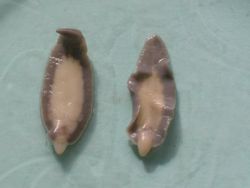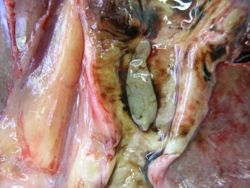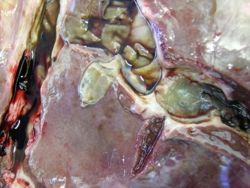Flukes - Donkey
Liver fluke - Fasciola hepatica
Introduction

At The Donkey Sanctuary, a 17% prevalence rate of Fasciola hepatica has been noted from post-mortem findings on a specific group of donkeys from Ireland. A high prevalence of infection associated with clinical disease and death has been reported in donkeys in Fasciola-endemic areas (Pankhurst, 1963, Fahmy and El-Attar, 1990).
In Ethiopia a high prevalence of fasciolosis (72%) has been reported from the highland Fasciola-endemic areas (Getachew et al, 2006). Donkeys may be infected chronically or sub-clinically so that the clinical effects may not always be discernable, but the parasites can have a significant effect on blood loss, production and performance. Studies in Bolivia showed that, next to domestic ruminants, donkeys are the second most important definitive hosts of F. hepatica, thus playing a significant zoonotic role in human infection (Mas-Coma et al, 1999).
Diagnosis

Clinical signs
Donkeys with flukes are often asymptomatic.
Laboratory tests
They may have liver enzyme levels within the normal range.
Diagnosis is confirmed by faecal egg counts using a modified sedimentation technique.
Post-mortem

Post-mortem examinations at The Donkey Sanctuary have revealed very little reaction to the presence of the flukes in the bile ducts or liver tissue in donkeys. However, Collins (1961) reported greyish-white thread-like scars over the entire surface of the liver, with thickenings of the hepatic bile ducts in donkeys that died of fasciolosis.
Similar post-mortem findings were reported from donkeys that died of F. gigantica infections in Egypt (Fahmy and El-Attar, 1990). Grey nodules (1 to 3 mm in diameter) blocking bile ducts were demonstrated in donkeys infected with large numbers of flukes.
Histopathology
Histopathological findings depicted a great deal of connective tissue in interlobular bile ducts.
Treatment
- Triclabendazole is an effective treatment but has no market authorisation for use in donkeys
Control
- Control measures include good pasture management such as using sheep on donkey pastures to reduce pasture burdens (sheep would also need to be treated)
- Improve drainage in wet or marshy areas
Literature Search
Use these links to find recent scientific publications via CAB Abstracts (log in required unless accessing from a subscribing organisation).
Liver fluke in donkeys publications
References
- Trawford, A. and Getachew, M. (2008) Parasites In Svendsen, E.D., Duncan, J. and Hadrill, D. (2008) The Professional Handbook of the Donkey, 4th edition, Whittet Books, Chapter 6
- Collins, D.R. (1961). ‘Fascioliasis in a Mexican burro’. JAVMA. 139 (12). pp 1321-1323.
- Fahmy, M.F.M., El-Attar, S.R. (1990). ‘Pathological study on fascioliasis in camels and solipeds’. Egyptian Journal of Comparative Pathology and Clinical Pathology, 3(2). pp 285-291.
- Getachew, M., Innocent, G., Trawford, A., Feseha, G., Reid, S.J.W., and Love, S. (2006). ‘Equine cestodosis: a sero-epidemiological study of Anoplocephala perfoliata infection in Ethiopia’. Proceedings of the 9th Congress of World Equine Veterinary Association. 22-26 January 2006. Marrakech, Morocco.
- Mas-Coma, M.S., Bargues, M.D., and Esteban, J.G. (1999). ‘Human fasciolosis’. In: Fasciolosis. Dalton, J.P. (ed). CAB International, Oxon. pp. 411-432.
- Pankhurst, J. W. (1963). ‘Liver flukes in donkeys’. Vet. Rec. 75. p 434.
|
|
This section was sponsored and content provided by THE DONKEY SANCTUARY |
|---|
